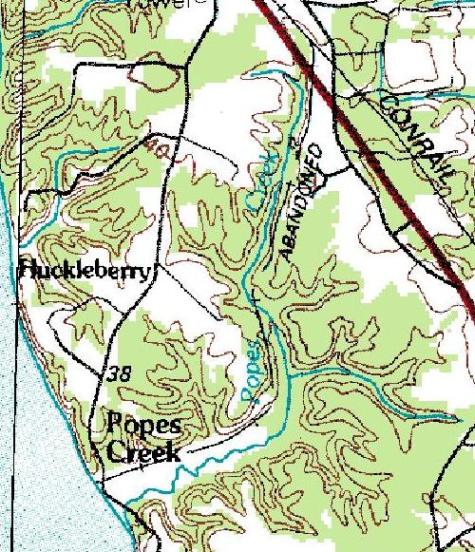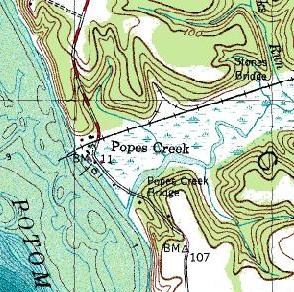 An exploration of Popes Creek, Calvert County, Maryland. 11/29/91.
An exploration of Popes Creek, Calvert County, Maryland. 11/29/91.
Desirous of getting to know the pocket watershed that Texaco hopes to despoil with its first Maryland coastal plain exploratory oil and gas well, Joe, Mark and I arranged to meet near its headwaters
I was late, having first dropped off a nature column I'd written to a small local newspaper, 'The Voice of Southern Maryland'. When I finally arrived at the rendezvous site, Joe and Mark were already there.
"How long've you been waiting?" we both asked, for all of us were late about the same amount! We decided to leave one car at the top of the watershed and travel to the bottom by the other.
This we did. Mark drove us to where Pope's Creek empties into the Potomac. It was as I had imagined: a wide valley full of marsh grasses, through which the creek meandered to the river. Dense forest on both sides sloped upwards. There was a crab house with a dock there, and an abandoned railroad station made of brick.
Our plan was to follow the now defunct railway line up the valley. The line parallels the creek on the map. Our information was that the rail line was still owned by Penn Central, thus we would not be trespassing on local landowners' property (shades of Gasperitch!)
We found the rail line and got on. It was well choked with brambles. The metal rails were gone, but the sleepers were still atop a raised cinder bed. They were well rotted, but still walkable.
A thin line of trees were between us and the marsh proper, which was a half mile wide. There were no signs bidding us stay out, as we traveled along. The track was covered with fallen oak leaves and crunched loudly underfoot. This made it difficult to go quietly, as I'd hoped.

After half a mile, we came to Drink's Run, a drowned valley to our left. The valley floor was covered by flattened light brown marsh grasses studded with numerous standing dead trees. Our map noted "Stone Bridge" at the creek's mouth and sure enough, when we scrambled off the bank, the track led over a well made brick and stone bridge.
Drink's Run, with many minnows in it, became a charming little brook on the Popes Creek side of the bridge that led into the marsh, which was still very wide at that point. We scared up a great Heron, which flapped heavily away; an eagle slid slowly over the marsh.
The valley curved slowly to the left over the next half mile, and the valley began to narrow. A lone cedar stood in the midst of the marsh, and a giant red oak grew near the track. I heard five different bird types.
There were numerous deer--both tracks and droppings were evident; we also noted extensive beaver colonies with many trees severed, both small and very large. Each colony had well made canals and, usually, several dams.
About two miles up from the Potomac, we noticed the sound of logging! Listening to the angry buzz, then the smash! of a tree falling. Then another. We paused and listened. The logging stopped; we heard the roar of a diesel engine.
Joe and Mark wanted to just sort of amble on past the logger, but I counseled caution "Gasparitch!" This was a recon, not a confrontation, after all, and the less anyone knew we were exploring the valley, the better.
I prevailed, and we waited, then heard the sound fading uphill. We determined he was climbing out of the valley and moved forward. He had gone up just south of Huckleberry Branch. The track was blocked with fallen trees. He’ll be back, we realized. Indeed, the roar was growing. We clambered through the tangle of fallen trees, the air full of sap smells, and raced for the bridge. Got over the bridge and round the curve before he reached the track.
A short while after Huckleberry Creek, we noticed, Popes Creek was now to our left. It had shrunk to a brook two feet wide and six inches deep. Fish and frogs abounded. The creek was silt-free, its bottom made of hard clay.
Three miles up and the canyon was now much narrower. On our right we saw a cinderblock building. It was surrounded by a chain link fence topped by barbed wire. Inside the wire, hundreds of steel drums lay rusting against the building.
Joe and Mark explored, while I examined a dirt road, well maintained, that led across the canyon from the building. Many no trespassing signs. I didn't venture far.
Next to the building, an aged truck stood. As I looked at it, a man, deeply tanned, walked out of the woods to it. I knew he'd see me, so I called out as he climbed into it. He looked around, then spotted me.
I greeted him, told him we were going along the line bird watching. He was friendly, spoke with a thick Maryland accent. Joe and Mark reappeared. We talked for about five minutes.
He’d seen eagles up here, said a nest was visible way below in one of the creek mouths, probably Ellenboro. Plenty of hawks, too, cruised the valley.
The railroad hadn't run in twenty years. He said it had been used by metal salvagers that would take apart ships on the Potomac and bring the metal up the line to the main Penn Central rail line.
The building was an old paint factory, still in use two days a week, he said. This, I thought, probably qualified the place as a toxic dump, given all the barrels. He and I smoked cigarettes, then Mark, Joe and I continued up to the car, passing his associate along the way, who was filling or flattening an expanse next to a dump of paint cans.
We drove past the Demerest property, and back to the mouth of Pope's Creek. We had iced teas in the crab house, then parted.